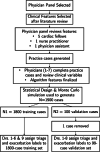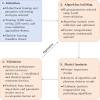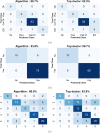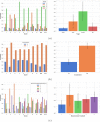A Machine Learning Methodology for Identification and Triage of Heart Failure Exacerbations
- PMID: 34453676
- PMCID: PMC8397870
- DOI: 10.1007/s12265-021-10151-7
A Machine Learning Methodology for Identification and Triage of Heart Failure Exacerbations
Abstract
Inadequate at-home management and self-awareness of heart failure (HF) exacerbations are known to be leading causes of the greater than 1 million estimated HF-related hospitalizations in the USA alone. Most current at-home HF management protocols include paper guidelines or exploratory health applications that lack rigor and validation at the level of the individual patient. We report on a novel triage methodology that uses machine learning predictions for real-time detection and assessment of exacerbations. Medical specialist opinions on statistically and clinically comprehensive, simulated patient cases were used to train and validate prediction algorithms. Model performance was assessed by comparison to physician panel consensus in a representative, out-of-sample validation set of 100 vignettes. Algorithm prediction accuracy and safety indicators surpassed all individual specialists in identifying consensus opinion on existence/severity of exacerbations and appropriate treatment response. The algorithms also scored the highest sensitivity, specificity, and PPV when assessing the need for emergency care. Here we develop a machine-learning approach for providing real-time decision support to adults diagnosed with congestive heart failure. The algorithm achieves higher exacerbation and triage classification performance than any individual physician when compared to physician consensus opinion.
Keywords: Congestive heart failure; Early detection and treatment; Exacerbation, triage; Machine learning; Telehealth monitoring; Triage.
© 2021. The Author(s).
Conflict of interest statement
James Morrill declares that he receives grant support from the Engineering and Physical Sciences Research Council under the program grant EP/L015803/1. Dr. Andrew Ambrosy declares that he is supported by a Mentored Patient-Oriented Research Career Development Award (K23HL150159) through the National Heart, Lung and Blood institute and he has received relevant research support through grants to his institution from Amarin Pharma, Inc., Abbott, and Novartis, including modest travel reimb from Novartis. Dr. Marat Fudim declares that he is supported by The National Heart, Lung, and Blood Institute grant K23HL151744; The American Heart Association grant 20IPA35310955; Mario Family Award; Duke Chair’s Award; Translating Duke Health Award; Bayer; and BTG Specialty Pharmaceuticals. He further receives consulting fees from AstraZeneca, AxonTherapies, CVRx, Daxor, Edwards LifeSciences, Galvani, NXT Biomedical, Zoll, Viscardia. Dr. Sumanth Swaminathan and Dr. Botros Toro both declare that they receive partial funding from the National Science Foundation Small Business Innovation Research Grant (no. 1950994) and that they are both shareholders of Vironix Health, Inc. Dr. Nicholas Wysham declares that he is a consultant for and shareholder of Vironix Health. Dr. Klajdi Qirko, Dr. Ted Smith, and Dr. Jacob Kelly declare that they have no conflicts of interest.
Figures






Similar articles
-
A machine learning approach to triaging patients with chronic obstructive pulmonary disease.PLoS One. 2017 Nov 22;12(11):e0188532. doi: 10.1371/journal.pone.0188532. eCollection 2017. PLoS One. 2017. PMID: 29166411 Free PMC article.
-
Assessing sensitivity and specificity of the Manchester Triage System in the evaluation of acute coronary syndrome in adult patients in emergency care: a systematic review protocol.JBI Database System Rev Implement Rep. 2015 Nov;13(11):64-73. doi: 10.11124/jbisrir-2015-2213. JBI Database System Rev Implement Rep. 2015. PMID: 26657465
-
Multisource Data Framework for Prehospital Emergency Triage in Real-Time IoMT-Based Telemedicine Systems.Int J Med Inform. 2024 Dec;192:105608. doi: 10.1016/j.ijmedinf.2024.105608. Epub 2024 Aug 30. Int J Med Inform. 2024. PMID: 39222600
-
A Machine Learning Approach to Predicting Need for Hospitalization for Pediatric Asthma Exacerbation at the Time of Emergency Department Triage.Acad Emerg Med. 2018 Dec;25(12):1463-1470. doi: 10.1111/acem.13655. Epub 2018 Nov 29. Acad Emerg Med. 2018. PMID: 30382605
-
A review on utilizing machine learning technology in the fields of electronic emergency triage and patient priority systems in telemedicine: Coherent taxonomy, motivations, open research challenges and recommendations for intelligent future work.Comput Methods Programs Biomed. 2021 Sep;209:106357. doi: 10.1016/j.cmpb.2021.106357. Epub 2021 Aug 16. Comput Methods Programs Biomed. 2021. PMID: 34438223 Review.
Cited by
-
The Aspects of Running Artificial Intelligence in Emergency Care; a Scoping Review.Arch Acad Emerg Med. 2023 May 11;11(1):e38. doi: 10.22037/aaem.v11i1.1974. eCollection 2023. Arch Acad Emerg Med. 2023. PMID: 37215232 Free PMC article.
-
Machine learning for the development of diagnostic models of decompensated heart failure or exacerbation of chronic obstructive pulmonary disease.Sci Rep. 2023 Aug 5;13(1):12709. doi: 10.1038/s41598-023-39329-6. Sci Rep. 2023. PMID: 37543661 Free PMC article. Clinical Trial.
-
Development, evaluation and comparison of machine learning algorithms for predicting in-hospital patient charges for congestive heart failure exacerbations, chronic obstructive pulmonary disease exacerbations and diabetic ketoacidosis.BioData Min. 2024 Sep 12;17(1):35. doi: 10.1186/s13040-024-00387-9. BioData Min. 2024. PMID: 39267093 Free PMC article.
-
Mapping and Summarizing the Research on AI Systems for Automating Medical History Taking and Triage: Scoping Review.J Med Internet Res. 2025 Feb 6;27:e53741. doi: 10.2196/53741. J Med Internet Res. 2025. PMID: 39913918 Free PMC article.
-
Extracting patient-level data from the electronic health record: Expanding opportunities for health system research.PLoS One. 2023 Mar 10;18(3):e0280342. doi: 10.1371/journal.pone.0280342. eCollection 2023. PLoS One. 2023. PMID: 36897886 Free PMC article.
References
Publication types
MeSH terms
Grants and funding
LinkOut - more resources
Full Text Sources
Medical
Research Materials
Miscellaneous

